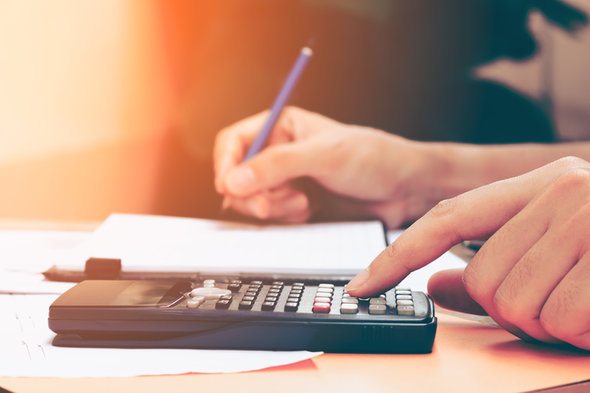There are a lot of things to think about when you get a credit card. Aside from getting the best credit card rewards, you’ll hear about things like balance transfers, credit scores and APRs. But what about a simpler question like how to pay your credit card bill? This can be done easily online these days, but understanding how it works and what your payment options are could be key to improving your budget. Working with a financial advisor can help you create the right financial plan that includes taking advantage of your credit accounts.
Credit Card Debt and How it Differs from Other Types of Debt
Credit card debt is known as “revolving debt,” and the term usually refers to any money you owe from an account that allows you to borrow against a credit line. Revolving debt often comes with a variable interest rate. And while you have to pay back whatever you borrow, you don’t have to pay a fixed amount every month according to a schedule.
Revolving credit accounts don’t have specific loan terms. That means you can borrow money as often as you need it. That’s not the case with installment credit accounts.
Unlike revolving debt, installment debt has to be paid back in fixed amounts over a set period of time. For example, let’s say you’re buying a $220,000 home. If you take on a $176,000 mortgage with a 30-year term and a 3% fixed interest rate, you could be expected to make a $742 mortgage payment every month for 360 months.
With installment loans, you’ll receive your entire loan amount up front. And while you may end up with an adjustable interest rate, in many cases, your interest rate will be fixed at the beginning of your loan term. Besides mortgage loans, common types of installment loans include student loans, car loans and personal loans.
What Dates Does Your Credit Card Bill Cover?
When it comes to paying your credit card bill, one of the most important things to know is your billing cycle. Each of your credit card bills will cover all the credit that you used (i.e. the money you spent with your credit card) within a certain period. This period is your billing cycle.
A billing cycle is usually about one month. You’ll hear many people refer to your billing cycle as a month. However, the exact dates will depend on when your card was issued. For example, your billing cycle might cover everything between from the third day of one month and the third day of the next month. If you don’t know the dates of your billing cycle, you can check your last bill (the dates should be on it). If you haven’t gotten a bill yet, check your card’s online banking system or call the card issuer’s customer service number.
How Much to Pay for Your Credit Card Bill
When you get your credit card statement, it will have two numbers: the balance that you owe and the minimum payment that you can make. If you pay your bill online, you may see a third option: your current balance. What do all these amounts mean?
The balance that you owe, which may be referred to as your “new balance,” your “statement balance” or something similar, is the amount that you spent during the previous billing cycle. This is the amount you need to pay in order to pay your bill in full.
The minimum payment is the minimum amount that you can pay. If you don’t pay at least that much, your credit card issuer will count it as a missed payment. If you pay at least the minimum but don’t pay the whole bill, the amount that you don’t pay will carry over to the next month. You will still need to pay this balance but you don’t have to pay it immediately. That may sound great but the downside is that any balance you carry from month to month will start accruing interest as soon as your bill’s due date passes. Paying only the minimum is a good way to rack up interest charges.
When you log in to your credit card’s online banking system, you may also a number that shows your current balance. This number includes your statement balance and the charges that you’ve made since the end of the billing cycle. That means you don’t actually owe this entire amount. You only owe the balance from your previous billing cycle.
How to Make Your Payment
At the end of every billing cycle, you will get your billing statement as either a paper statement in the mail or as an electronic statement. The statement is the same either way. The only difference is that one is paper and the other is digital. If you receive electronic statements, you can download a PDF of your statement to keep for your records.
Your billing statement will tell you how much you owe and it will also list all of your charges during the billing cycle. The first thing you should do is review all the charges to ensure that they are correct. If you believe there is an incorrect charge, contact your credit card issuer.
Once you get your billing statement, there are a few ways to pay. One way is to mail a check. If you choose to mail a check, there is a tear-off slip in your billing statement that you should send in with your check. The slip will have your account number, the address where you should mail the check, your statement balance and your minimum payment. It will also have a space for you to write in the payment amount that you are making.
If you use online banking, you can also transfer money directly from your bank to the credit card issuer. This payment will go through the ACH network and the transaction could be as fast as one or two days. Just be aware that your bank may charge a fee in order to transfer money out of your account.
If you want to pay your bill through your credit card’s online banking system, you can also link your bank account to your credit card account. This allows your credit card issuer to draw funds from your bank account in order to pay your bill.
Linking your bank account also allows you to set up automatic payments. With automatic payments, your credit card issuer will automatically withdraw the funds to pay your bill once the bill is available. This is a great option so that you don’t have to remind yourself to pay your bill on time. Some credit card issuers also offer a small reward for paying your bill on the first day that your billing statement is available.
Another option for paying your bill is over the phone. Simply call the number on your billing statement and provide your bank information. Certain credit cards let you pay in cash at a local bank, Western Union or other location.
How Long Do You Have to Pay Your Credit Card Bill?

When your billing cycle ends, your credit card issuer will send you a bill. If you have signed up for paperless statements, your bill should be available within a couple of days. If you have elected to receive your bill in the mail, you’ll need to wait for the bill to arrive. Once your bill is available, you will have a certain amount of time, called a grace period, before your card issuer needs to have your payment.
The grace period for paying your bill will be at least 21 days. It may be slightly longer depending on your credit card. If your grace period is 21 days, that means you have 21 days for the card issuer to receive at least enough money for your minimum payment.
Keep in mind that the grace period starts when your bill is available and not necessarily when you get it. If you get your bill through the mail, the time that your bill is traveling in the mail counts as part of that grace period.
To avoid any fees or interest payments, make sure to pay your credit card bill in full by the due date. That will require you to send your payment before its actual due date. Online payments usually take just a couple of days but you may need your entire grace period if you’re sending a check in the mail to pay your credit card bill.
What If You Don’t Pay Your Whole Bill on Time?
If you pay your entire bill in full by the due date, you don’t have to worry about any fees or interest. If you don’t pay your bill in full by the due date, then your credit card issuer will start to charge you interest. You may also have to pay fees.
Sometimes it isn’t possible for you to pay your credit card bill by the due date. There are a few scenarios that may occur if you don’t pay your bill in full or on time.
The first scenario is that you make the minimum payment and then you have to pay interest on the remaining balance. If you pay at least the minimum, you avoid any late fees. You will have interest charges though. Credit card interest rates are often 20% or more so you should make sure you know how much credit card debt you’ll be paying before you decide to carry a balance.
So if you only pay the minimum on your credit card bill, you will start to accrue interest charges. What if you don’t make a payment at all?
What If You Don’t Pay Your Credit Card Bill at All?
If you don’t make at least the minimum payment by your bill’s due date, the first thing you will have to do is pay a late fee. The fee amount varies depending on your credit card and the number of times that you have made a late payment in the recent past. (The Credit CARD Act of 2009 created a limit to how much credit card companies could charge in late fees.) You can find the amount of the late fee in your card’s terms and conditions (within the Schumer Box to be more specific).
If you do not make any payment or if you don’t pay at least the minimum within 30 days of the due date, the credit card issuer will report the missed payment to credit bureaus. That will negatively impact your credit score.
If you don’t make the minimum payment on your account for more than 60 days, your credit issuer will increase your APR to a higher rate. This higher rate is called a penalty APR. It could be twice as high as your card’s standard APR in some cases. You will also have to pay that penalty APR for six months or more before your card issuer will consider lowering it back to your standard APR.
If you don’t make the minimum payment for a few months, your credit card issuer could mark your account as delinquent. Some issuers will wait longer before doing this but it generally happens after 180 days without payment on your account. At this point, your credit card issuer might send your bill to a collection agency.
Having your debt goes into collections could have a hugely negative impact on your credit score. The exact effect on your credit score will depend on how much you owe.
Can You Pay Your Credit Card Bill Early?
In order to avoid interest and fees, you only need to pay your bill by its due date. However, you can send payments before the due date and at any time during your billing cycle. Your credit card issuer will simply apply the payment to your account. If you haven’t spent any money during that billing cycle, the payment will become credited to your account.
Paying some of your balance during the billing cycle, before the closing date, could be beneficial. It could particularly help you if you have a low credit limit. Credit utilization – how much of your total credit line you are using – accounts for about one-third of your credit score. Your score will be better if you maintain a low credit utilization. Ideally, you want to keep your utilization rate below 30% of your available credit. If you have a low credit limit, making payments throughout a billing cycle is one way to keep your credit utilization low.
Making an early payment will also help you to minimize interest if you are carrying a balance. Your credit card issuer calculates interest charges by averaging how much money you owe on each day during the billing cycle. If you make an early payment, you decrease the amount you owe. That will also decrease your interest charges.
Bottom Line

Ultimately, the best way to pay your credit card is in full and on time every month. That will keep you from paying late fees or interest. If you cannot afford to pay your statement in full, you must make at least the minimum payment. The amount that you don’t pay will carry over to the next month and your card issuer will start charging you interest. Credit card interest adds up quickly so try to minimize the balances you carry.
Tips on Paying Your Credit Card Bill
- Properly managing your credit can be difficult if you don’t have a strong financial budget and overall long-term plan. A financial advisor can help create that plan and give you the tools needed to right your finances. Finding a financial advisor doesn’t have to be hard. SmartAsset’s free tool matches you with up to three vetted financial advisors who serve your area, and you can have free introductory calls with your advisor matches to decide which one you feel is right for you. If you’re ready to find an advisor who can help you achieve your financial goals, get started now.
- A credit card billing cycle covers about one month and many people plan their budgets monthly. That makes your statement a useful tool for budgeting and tracking your spending. The challenge is that a billing cycle rarely lines up perfectly with a calendar month. Luckily you can change your billing cycle by changing your bill’s due date.
- Try to always pay your bill in full and on time. Carrying debt may be convenient sometimes but interest adds up quickly. If you can’t pay your bill in full, pay as much as you can and make at least the minimum payment. Consider making partial payments throughout the month in order to minimize your interest charges. Because of how credit card issuers calculate interest, you will save more on interest if you make additional payments close to the start date of your billing cycle.
Photo credits: ©iStock.com/Peopleimages, ©iStock.com/wutwhanfoto, ©iStock.com/AntonioGuillem
